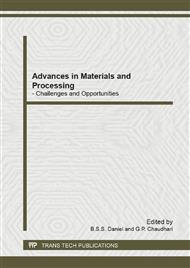p.82
p.87
p.95
p.100
p.105
p.110
p.115
p.120
p.124
Optical Study on Gadolinium Oxide Nanoparticles Synthesized by Hydrothermal Method
Abstract:
Cubic phase gadolinium oxide nanoparticles were prepared by hydrothermal method at various reaction temperatures like 60 °C, 120 °C, 180 °C and 240 °C. X-ray Diffraction (XRD) studies confirmed the formation of cubic phase Gd2O3. The broadening of XRD peak, due to crystallite size was investigated with the aid of gaussian and voigt peak fitting function and its comparisons were also performed. Crystallite size calculated from Scherrer formula for Gd2O3 nanoparticles for various reactions temperatures varies between 21 nm and 39 nm. Thermal analysis of as-prepared sample was done and the decomposition temperature was found to be 433 °C for the formation of Gd2O3. The metal-oxygen band in Fourier Transform Infrared Spectroscopy (FTIR) spectra confirmed the presence of Gd2O3. Band gap studies from Diffuse Reflectance Spectroscopy (DRS) revealed the decrease in band gap with respect to the increase in crystallite size. In Photoluminescence (PL) spectra, a broad ultra violet emission is observed between 320 nm and 400 nm. Irrespective of reaction temperature, Scanning Electron Microscopy (SEM) images reported the formation of nanorods.
Info:
Periodical:
Pages:
105-109
Citation:
Online since:
November 2012
Authors:
Keywords:
Price:
Сopyright:
© 2012 Trans Tech Publications Ltd. All Rights Reserved
Share:
Citation:


